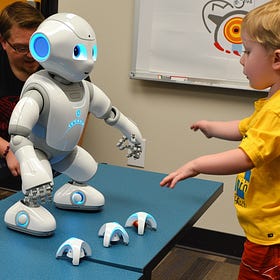#38 - Intelligence and Overfit
The other side of the double edged sword of increased intelligence
Last time we spoke about intelligence and pattern recognition:
#37 - Pattern Recognition & Intelligence
While there are many ways to look at and define intelligence, essentially all research points to a core, general intelligence (referred to as g in academic literature), as the governing factor for people. Put another way, g is the speed limit of a human brain, and we all have slightly different ones.
As promised, today we’ll look at the downsides of excellent pattern recognition in humans (and AI).
Looking at computers, even before AI they were exceptional pattern recognition engines If intelligence were fully defined by pattern recognition, computers may already be superior to their creators. Even using basic techniques like regression, computers are often able to spot relationships that humans miss.
But the downfall of computer pattern recognition, as any good data scientist knows, is overfitting. In lay terms, overfitting is when a model identifies a trend that wasn’t real and rather just an accident of randomness within the data. Such a relationship will do well to explain the past, but will be useless (or worse) at predicting the future.
Put practically, imagine the following. You feed a computer a bunch of people’s height, weight, hair color, shoe size and ask it to determine whether they are left-handed. The computer will draw the best relationship it can from this – one which may explain a lot or all of the data you provide. But as each of these factors is (to my knowledge) uncorrelated with left-handedness, the model will be worthless when predicting if a new person is left-handed.
It’s broadly been recognized that humans also suffer from overfitting. Superstitions can be seen as us overfitting behavior models: we saw something bad happen once when a guy walked under a ladder, so now no one should do it.
More practically, the work of Nobel Prize winning economist Daniel Kahneman shows how humans systematically are biased in our thinking, with anchoring and loss aversion biases being two of the most common. Each of these merits its own coverage at some point.
With that all said, let’s link this back to intelligence. More intelligence leads to more pattern recognition, but it does not ensure that these patterns are real. They may be, and often are spurious overfits. This is a handicap that comes with intelligence. This is why, as Naval Ravikant put it on a recent episode of his podcast, “Judgement is the Decisive Skill,” and why he states in it that “Intellect without any experience is often worse than useless.”
Judging how much a smart person overfits with their additional pattern recognition skills is a fool’s errand, and would vary greatly from person to person. Thus I’ll bring in my personal experience: I’ve seen many objectively smart people be overconfident in “proven” ideas.
Case-in-point: many people seem sure to trust that the science (or “The Science”) is absolute, without considering all the reasons the science could be off: financial incentives from government and industry, p-hacking done to make a name and a splash with a controversial result, tertiary factors being overlooked that obscure or drive the real effect, and so much more.
My bias is to opt on the side of caution. Whether we call it judgement or call it wisdom, it’s better to admit that we don’t yet know something. If we act to hastily with certainty, the unintended consequences around are almost always powerful and hard-to-predict.



